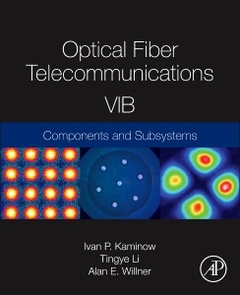Description
Optical Fiber Telecommunications Volume VIB (6th Ed.)
Systems and Networks
Optics and Photonics Series
Coordinators: Kaminow Ivan, Li Tingye, Willner Alan E.
Language: English
Subjects for Optical Fiber Telecommunications Volume VIB:
1148 p. · 19x23.3 cm · Hardback
Description
/li>Contents
/li>Readership
/li>Biography
/li>Comment
/li>
Optical Fiber Telecommunications VI (A&B) is the sixth in a series that has chronicled the progress in the R&D of lightwave communications since the early 1970s. Written by active authorities from academia and industry, this edition brings a fresh look to many essential topics, including devices, subsystems, systems and networks. A central theme is the enabling of high-bandwidth communications in a cost-effective manner for the development of customer applications. These volumes are an ideal reference for R&D engineers and managers, optical systems implementers, university researchers and students, network operators, and investors.
Volume A is devoted to components and subsystems, including photonic integrated circuits, multicore and few-mode fibers, photonic crystals, silicon photonics, signal processing, and optical interconnections.
Volume B is devoted to systems and networks, including advanced modulation formats, coherent detection, Tb/s channels, space-division multiplexing, reconfigurable networks, broadband access, undersea cable, satellite communications, and microwave photonics.
1. Capacity of Fibers in Optical Networks 2. Commercial 100-Gbit/s Coherent Transmission Systems 3. Advances in Tbit/s Superchannels; Optical Satellite Communications 4. Advanced DSP for Optical Communication Systems 5. Advanced Coding for Optical Communications 6. Extremely Higher-Order Modulation Formats 7. Multicarrier Optical Transmission 8. Optical Encoding/Decoding of OFDM & Nyquist Signals 9. Multi-Orthogonal-Mode Multichannel Systems 10. Mode Coupling and its Impact on Spatially Multiplexed Systems 11. Multimode Communications using OAM 12. Transmission Systems using Multicore Fibers 13. Elastic Optical Networking; ROADM-Node Architectures for Reconfigurable Photonic Networks 14. Convergence of IP and Optical Networking; Energy Efficient Telecommunications 15. Advancements in Metro Regional and Core Transport Network Architectures for the Next-Generation Internet 16. Novel Architectures for Streaming / Routing in Optical Networks 17. Recent advances in high-frequency (> 10 GHz) microwave photonics: Enhanced-performance links and the novel functionalities they enable 18. Recent advances in high-frequency (> 10 GHz) microwave photonics 19. All-band Optical Wireless Access Networks using Radio over Fiber Technologies; PONs: State of the Art and Standardized 20. Wavelength-Division-Multiplexed Passive Optical Networks (WDM PONs) 21. FTTx Worldwide Deployment.
Ivan Kaminow retired from Bell Labs in 1996 after a 42-year career. He conducted seminal studies on electrooptic modulators and materials, Raman scattering in ferroelectrics, integrated optics, semiconductor lasers (DBR , ridge-waveguide InGaAsP and multi-frequency), birefringent optical fibers, and WDM networks. Later, he led research on WDM components (EDFAs, AWGs and fiber Fabry-Perot Filters), and on WDM local and wide area networks. He is a member of the National Academy of Engineering and a recipient of the IEEE/OSA John Tyndall, OSA Charles Townes and IEEE/LEOS Quantum Electronics Awards. Since 2004, he has been Adjunct Professor of Electrical Engineering at the University of California, Berkeley.
Tingye Li retired from AT&T in 1998 after a 41-year career at Bell Labs and AT&T Labs. His seminal work on laser resonator modes is considered a classic. Since the late 1960s, he and his groups have conducted pioneering studies on lightwave technologies and systems. He led the work on amplified WDM transmission systems and championed their deployment for upgrading network capacity. He is a member of the National Academy of Engineering and a foreign member of the Chinese Academy of Engineering. He is a recipient of the IEEE David Sarnoff Award, IEEE/OSA John Tyndall Award, OSA Ives Me
- All the latest technologies and techniques for developing future components and systems
- Edited by two winners of the highly prestigious OSA/IEEE John Tyndal award and a President of IEEE's Lasers & Electro-Optics Society (7,000 members)
- Written by leading experts in the field, it is the most authoritative and comprehensive reference on optical engineering on the market
These books may interest you

Optical Fiber Telecommunications VII 179.27 €



